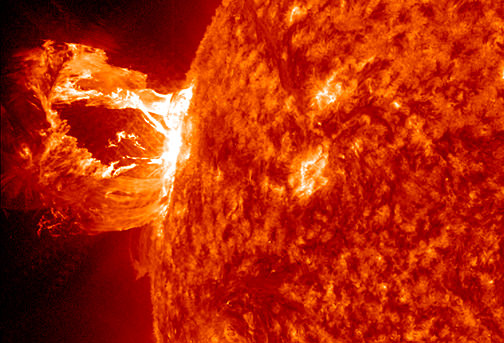What’s more fun than something that misbehaves? When it comes to solar dynamics, we know a lot, but there are many things we don’t yet understand. For example, when a particle filled solar flare lashes out from the Sun, its magnetic field lines can do some pretty unexpected things – like split apart and then rapidly reconnect. According to the flux-freezing theorem, these magnetic lines should simply “flow away in lock-step” with the particles. They should stay intact, but they don’t. It’s not just a simple rule they break… it’s a law of physics.
What can explain it? In a paper published in the May 23 issue of “Nature”, an interdisciplinary research team led by a Johns Hopkins mathematical physicist may just have found a plausible explanation. According to the group, the underlying factor is turbulence – the “same sort of violent disorder that can jostle a passenger jet when it occurs in the atmosphere” – or the one your brother leaves behind after he’s eaten baked beans. By employing a well-organized and logically constructed computer modeling technique, the researchers were able to simulate what happens when magnetic field lines meet up with turbulence in a solar flare. Armed with this information, they were then able to state their case.
“The flux-freezing theorem often explains things beautifully,” said Gregory Eyink, a Department of Applied Mathematics and Statistics professor who was lead author of the “Nature” study. “But in other instances, it fails miserably. We wanted to figure out why this failure occurs.”
Just what is the flux-freezing theorem? Maybe you’ve heard of Hannes Alfvén. He was a Swedish electrical engineer, plasma physicist and winner of the 1970 Nobel Prize in Physics for his work on magnetohydrodynamics (MHD). He’s the man responsible for explaining what we now know as Alfvén waves – a low-frequency travelling oscillation of the ions and the magnetic field in plasma. Well, some 70 years ago, he came up with the thought that magnetic lines of force sail along a locomotive fluid similar to snippets of thread flowing along a stream. It should be impossible for them to break and then join again. However, solar physicists have discovered this just isn’t the case when it comes to activity within a particularly violent solar flare. In their observations, they have determined that the magnetic field lines within these flares can stretch to the breaking point and then reconnect in a surprisingly quick amount of time – as little as 15 minutes. When this happens, it expels a copious amount of energy which, in turn, powers the flare.
“But the flux-freezing principle of modern plasma physics implies that this process in the solar corona should take a million years!” Eyink animatedly states. “A big problem in astrophysics is that no one could explain why flux-freezing works in some cases but not others.”
Of course, there has always been speculation that turbulence may have been the root source of the enigmatic behavior. Time for investigation? You bet. Eyink then joined forces – and minds – with other experts in astrophysics, mechanical engineering, data management and computer science, based at Johns Hopkins and other institutions. “By necessity, this was a highly collaborative effort,” Eyink said. “Everyone was contributing their expertise. No one person could have accomplished this.”

Of course, other solar experts feel there may be alternative answers for this rule-breaking activity within solar flares, but as Eyink says, “I think we made a pretty compelling case that turbulence alone can account for field-line breaking.”
What is most exciting is the collaborative effort of the team members from such widely varied disciplines. It was a group effort which aided Eyink to come up with this new theory on the solar flare riddle. “We used ground-breaking new database methods, like those employed in the Sloan Digital Sky Survey, combined with high-performance computing techniques and original mathematical developments,” he said. “The work required a perfect marriage of physics, mathematics and computer science to develop a fundamentally new approach to performing research with very large datasets.”
In conclusion, Eyink noted this type of research work may very well give us a better understanding of solar flares and coronal mass ejections. As we know, this type of dangerous “space weather” can be harmful to astronauts, disrupt communications satellites, and even be responsible for the shut-down of electrical power grids on Earth. And you know what that means… no satellite TV and no power to watch it by. But, that’s O.K.
“I don’t stay out late. Don’t care to go. I’m home about eight… Just me and my radio. Ain’t misbehavin’.. Savin’ my love for you.”
Original Story Source: Johns Hopkins University News Release.


Scientists often confuse their data with reality. There are no lines in space. The lines are on the graphs they use to study these phenomena. Just so its clear to everyone…
This is what I’m talkin bout here! If you never add the lines in your perception you are guaranteed to not understand it. It spent many countless days unable to move from a thrown out back. And I would think about things like this the whole time. I have a deep appreciation for it and the ones that are smart enough to make the Graphs to prove it. Just wish the world would see it too. Thanks for the story.
What is it that is “turbulent”? The aether? Why not talk about magnetic fields rather than lines.?
I believe they’re talking about the movement of the charged particles in the plasma.
Turbulence is a property of “fluids”, therefore it cannot be applied to the magnetic field itself, but people tend to mix a little the movement of the (charged) particles with the field itself in the description of plasmas, but this is only approximation.
Alfven later severely qualified the usage of the “frozen-in” field lines see: http://www.google.com/url?sa=t&rct=j&q=alfven%20frozrn%20in&source=web&cd=3&sqi=2&ved=0CDgQFjAC&url=http%3A%2F%2Fplasma.colorado.edu%2Fphys7810%2Farticles%2FAlfven_FieldLines_1976.pdf&ei=aS2eUcvcL7X54AP6lYDACA&usg=AFQjCNHgO5JHxlrKT1J9zuck5oq71dRrAw&cad=rja
It wasn’t solar physicists that discovered that the frozen-in concept breaks down, but Alfvén himself, who described it as a “pseudo pedagogical concept”. See: “On frozen-in field lines and field-line reconnection”, in Journal of Geophysical Research, vol. 81, Aug. 1, 1976, p. 4019-4021. Abstract: http://adsabs.harvard.edu//abs/1976JGR….81.4019AFull text PDF: http://plasma.colorado.edu/phys7810/articles/Alfven_FieldLines_1976.pdf
Thanks for the links!